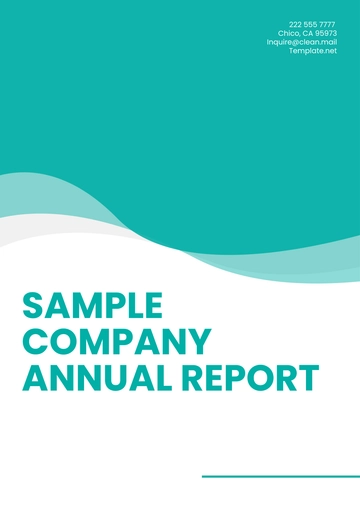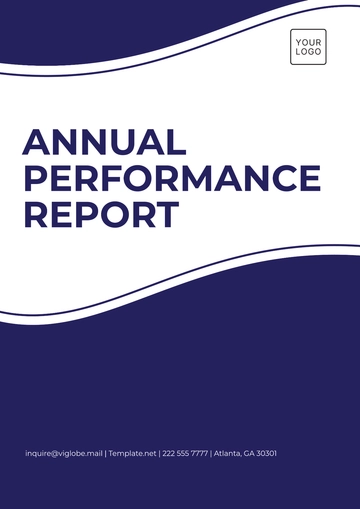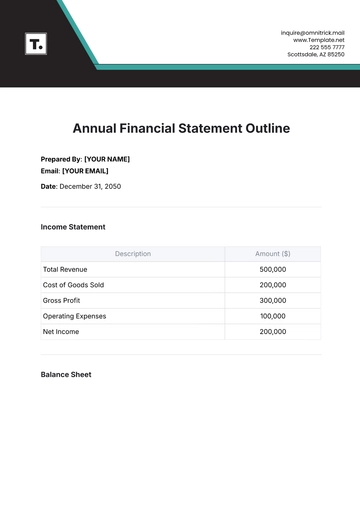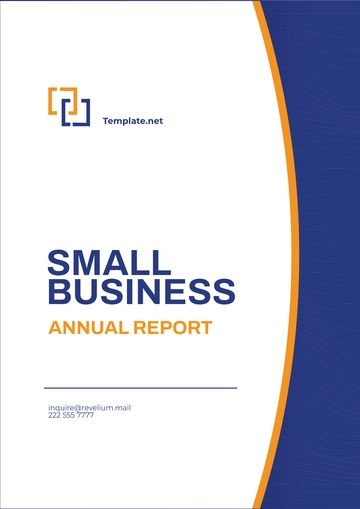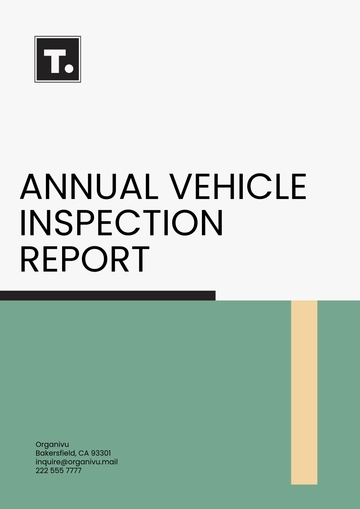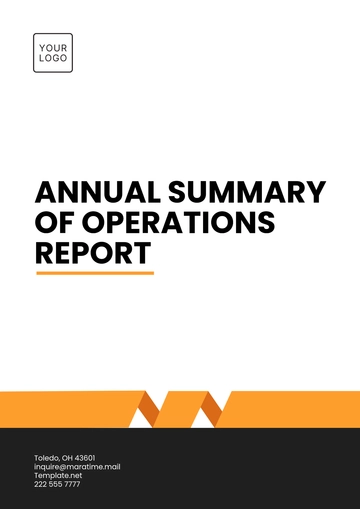Free Agriculture Annual Sales Report
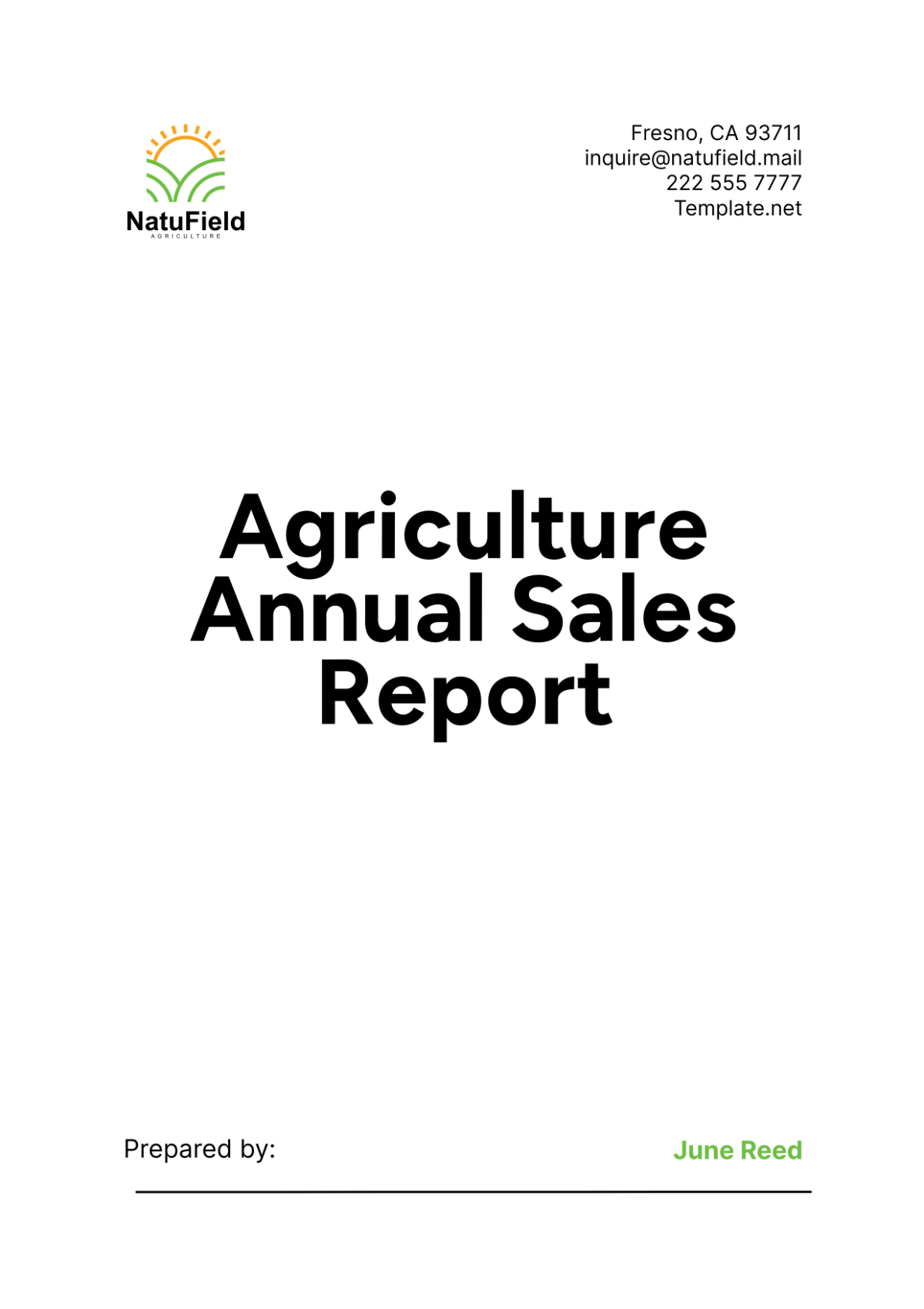
Date: January 5, 2050
Introduction
The Agriculture Annual Sales Report for [Your Company Name] provides a detailed analysis of the sales performance for the year 2050. This report aims to present a comprehensive overview of our sales achievements, revenue growth, market trends, and strategic initiatives. It serves as a valuable tool for stakeholders to understand our market position, operational efficiency, and areas for improvement.
1. Sales Performance Overview
This chapter provides an overview of [Your Company Name]'s sales performance for the year 2050. It includes annual, quarterly, and monthly sales summaries to give a comprehensive picture of revenue trends, units sold, and average selling prices throughout the year.
1.1 Annual Sales Summary
Objective: To provide a high-level summary of annual sales performance.
Summary:
Total Sales Revenue: $10,000,000
Total Units Sold: 250,000 units
Average Selling Price: $40 per unit
Table: Annual Sales Summary
Metric | Amount ($) | Percentage Change |
|---|---|---|
Total Sales Revenue | 10,000,000 | +12% |
Total Units Sold | 250,000 | +10% |
Average Selling Price | 40 | +2% |
1.2 Quarterly Sales Performance
Objective: To analyze sales performance on a quarterly basis.
Table: Quarterly Sales Performance
Quarter | Revenue ($) | Units Sold | Average Selling Price ($) |
|---|---|---|---|
Q1 | 2,200,000 | 55,000 | 40 |
Q2 | 2,500,000 | 62,500 | 40 |
Q3 | 2,800,000 | 70,000 | 40 |
Q4 | 2,500,000 | 62,500 | 40 |
1.3 Monthly Sales Performance
Objective: To provide a detailed breakdown of monthly sales performance.
Table: Monthly Sales Performance
Month | Revenue ($) | Units Sold | Average Selling Price ($) |
|---|---|---|---|
January | 700,000 | 17,500 | 40 |
February | 700,000 | 17,500 | 40 |
March | 800,000 | 20,000 | 40 |
April | 800,000 | 20,000 | 40 |
May | 900,000 | 22,500 | 40 |
June | 800,000 | 20,000 | 40 |
July | 900,000 | 22,500 | 40 |
August | 900,000 | 22,500 | 40 |
September | 1,000,000 | 25,000 | 40 |
October | 800,000 | 20,000 | 40 |
November | 800,000 | 20,000 | 40 |
December | 900,000 | 22,500 | 40 |
2. Market Analysis
In this chapter, we analyze the key market trends and competitive landscape that influenced our sales performance in 2050. Understanding these factors helps us identify opportunities and challenges in the market, allowing us to strategize effectively for future growth.
2.1 Market Trends
Objective: To analyze the key market trends influencing sales performance.
Key Trends:
Increase in Demand for Organic Products: A growing consumer preference for organic and sustainably sourced products has positively impacted sales.
Technological Advancements: Adoption of advanced agricultural technologies has improved production efficiency and product quality.
Market Expansion: Entry into new regional markets has expanded the customer base and increased revenue.
2.2 Competitive Analysis
Objective: To assess the competitive landscape and our market position.
Table: Competitive Analysis
Competitor | Market Share (%) | Strengths | Weaknesses |
|---|---|---|---|
Competitor A | 25 | Strong brand recognition | Limited product variety |
Competitor B | 20 | Competitive pricing | Low customer loyalty |
Competitor C | 15 | Wide distribution network | Higher prices |
[Your Company Name] | 10 | High-quality, sustainable products | Limited market presence |
2.3 Customer Analysis
Objective: To understand customer demographics and purchasing behavior.
Demographics:
Age Group: 25-50 years
Income Level: Middle to high income
Location: Predominantly urban areas
Buying Behavior:
Preferences: Preference for organic and sustainable products
Channels: Predominantly purchases through local markets and online platforms
Frequency: Regular, repeat purchases
3. Sales by Product Category
This chapter breaks down sales by product category, highlighting the performance of different agricultural products. It identifies top-selling products and their contribution to overall revenue, providing insights into customer preferences and product demand.
3.1 Product Category Overview
Objective: To provide a breakdown of sales by product category.
Table: Sales by Product Category
Product Category | Revenue ($) | Units Sold | Average Selling Price ($) | Percentage of Total Revenue |
|---|---|---|---|---|
Fruits | 4,000,000 | 100,000 | 40 | 40% |
Vegetables | 3,000,000 | 75,000 | 40 | 30% |
Grains | 2,000,000 | 50,000 | 40 | 20% |
Dairy | 1,000,000 | 25,000 | 40 | 10% |
3.2 Top-Selling Products
Objective: To highlight the top-selling products within each category.
Table: Top-Selling Products
Product | Category | Revenue ($) | Units Sold | Average Selling Price ($) |
|---|---|---|---|---|
Organic Apples | Fruits | 1,200,000 | 30,000 | 40 |
Organic Carrots | Vegetables | 800,000 | 20,000 | 40 |
Whole Wheat Bread | Grains | 600,000 | 15,000 | 40 |
Organic Milk | Dairy | 400,000 | 10,000 | 40 |
4. Sales by Region
In this chapter, we examine the geographical distribution of sales, analyzing revenue and units sold across different regions. This analysis helps us understand regional market dynamics and identify areas with the highest growth potential.
4.1 Regional Sales Overview
Objective: To provide a breakdown of sales by geographic region.
Table: Regional Sales Overview
Region | Revenue ($) | Units Sold | Percentage of Total Revenue |
|---|---|---|---|
North America | 4,500,000 | 112,500 | 45% |
Europe | 3,000,000 | 75,000 | 30% |
Asia | 2,000,000 | 50,000 | 20% |
South America | 500,000 | 12,500 | 5% |
4.2 Sales Growth by Region
Objective: To analyze sales growth in each region.
Table: Sales Growth by Region
Region | Revenue 2049 ($) | Revenue 2050 ($) | Growth Rate (%) |
|---|---|---|---|
North America | 4,000,000 | 4,500,000 | 12.5% |
Europe | 2,500,000 | 3,000,000 | 20% |
Asia | 1,800,000 | 2,000,000 | 11.1% |
South America | 400,000 | 500,000 | 25% |
5. Sales Channel Analysis
This chapter focuses on the performance of various sales channels, such as direct sales, online sales, and distributor sales. By evaluating the effectiveness of each channel, we can optimize our distribution strategy to maximize revenue and reach.
5.1 Sales by Channel
Objective: To provide a breakdown of sales by distribution channel.
Table: Sales by Channel
Channel | Revenue ($) | Units Sold | Percentage of Total Revenue |
|---|---|---|---|
Direct Sales | 5,000,000 | 125,000 | 50% |
Online Sales | 3,000,000 | 75,000 | 30% |
Distributor Sales | 2,000,000 | 50,000 | 20% |
5.2 Channel Performance
Objective: To assess the performance of each sales channel.
Analysis:
Direct Sales: Achieved the highest revenue, accounting for 50% of total sales, with strong performance in both urban and rural areas.
Online Sales: Represented 30% of total revenue, driven by increased e-commerce activity and digital marketing efforts.
Distributor Sales: Contributed 20% of total revenue, with a focus on bulk purchases and long-term contracts.
6. Customer Satisfaction
In this chapter, we assess customer satisfaction levels through feedback and retention metrics. Understanding customer satisfaction helps us improve our products and services, ensuring long-term loyalty and repeat business.
6.1 Customer Feedback
Objective: To analyze customer feedback and satisfaction levels.
Summary:
Overall Satisfaction: 85%
Product Quality Satisfaction: 90%
Customer Service Satisfaction: 80%
Table: Customer Satisfaction Survey
Metric | Very Satisfied | Satisfied | Neutral | Dissatisfied | Very Dissatisfied |
|---|---|---|---|---|---|
Overall Satisfaction | 45% | 40% | 10% | 3% | 2% |
Product Quality | 50% | 40% | 5% | 3% | 2% |
Customer Service | 40% | 40% | 15% | 3% | 2% |
6.2 Customer Retention
Objective: To measure customer retention rates.
Analysis:
Annual Retention Rate: 75%
Repeat Purchase Rate: 60%
Customer Churn Rate: 25%
Table: Customer Retention Metrics
Metric | Percentage (%) |
|---|---|
Annual Retention Rate | 75% |
Repeat Purchase Rate | 60% |
Customer Churn Rate | 25% |
7. Sales Strategy and Recommendations
The final chapter outlines our sales strategy for the upcoming year and provides actionable recommendations based on the analysis of 2050 sales performance. These strategies and recommendations aim to drive growth, enhance customer engagement, and optimize operations for better efficiency and profitability.
7.1 Sales Strategy
Objective: To outline the sales strategy for the upcoming year.
Strategies:
Market Expansion: Enter new regional markets to diversify revenue streams.
Product Diversification: Introduce new product lines to meet changing consumer preferences.
Digital Transformation: Enhance online sales channels and leverage digital marketing.
7.2 Recommendations
Objective: To provide actionable recommendations based on the sales analysis.
Recommendations:
Strengthen Market Presence:
Increase brand visibility through targeted marketing campaigns.
Expand distribution networks to reach underserved areas.
Enhance Customer Engagement:
Implement loyalty programs to increase customer retention.
Improve customer service through training and technology upgrades.
Optimize Operations:
Invest in supply chain improvements to reduce costs and enhance efficiency.
Adopt advanced technologies for inventory management and sales tracking.
Focus on Sustainability:
Promote sustainable practices and products to meet consumer demand.
Obtain relevant certifications to enhance product credibility.
Conclusion
The Agriculture Annual Sales Report for [Your Company Name] highlights a successful year with significant growth in revenue and market presence. By leveraging market trends, enhancing customer satisfaction, and optimizing sales strategies, we have positioned ourselves for continued success in the coming years. The insights and recommendations provided in this report will guide our efforts to achieve even greater milestones in the future.
Prepared by:
[Your Name]
[Your Title]
[Your Company Name]
[Your Company Email]
- 100% Customizable, free editor
- Access 1 Million+ Templates, photo’s & graphics
- Download or share as a template
- Click and replace photos, graphics, text, backgrounds
- Resize, crop, AI write & more
- Access advanced editor
Elevate your year-end reviews with Template.net's Agriculture Annual Sales Report Template. Tailored for the agricultural sector and fully editable with our AI editor, this customizable template allows you to compile and present annual sales data effectively. Analyze trends, track performance against goals, and strategize for the future with clarity and precision.
You may also like
- Sales Report
- Daily Report
- Project Report
- Business Report
- Weekly Report
- Incident Report
- Annual Report
- Report Layout
- Report Design
- Progress Report
- Marketing Report
- Company Report
- Monthly Report
- Audit Report
- Status Report
- School Report
- Reports Hr
- Management Report
- Project Status Report
- Handover Report
- Health And Safety Report
- Restaurant Report
- Construction Report
- Research Report
- Evaluation Report
- Investigation Report
- Employee Report
- Advertising Report
- Weekly Status Report
- Project Management Report
- Finance Report
- Service Report
- Technical Report
- Meeting Report
- Quarterly Report
- Inspection Report
- Medical Report
- Test Report
- Summary Report
- Inventory Report
- Valuation Report
- Operations Report
- Payroll Report
- Training Report
- Job Report
- Case Report
- Performance Report
- Board Report
- Internal Audit Report
- Student Report
- Monthly Management Report
- Small Business Report
- Accident Report
- Call Center Report
- Activity Report
- IT and Software Report
- Internship Report
- Visit Report
- Product Report
- Book Report
- Property Report
- Recruitment Report
- University Report
- Event Report
- SEO Report
- Conference Report
- Narrative Report
- Nursing Home Report
- Preschool Report
- Call Report
- Customer Report
- Employee Incident Report
- Accomplishment Report
- Social Media Report
- Work From Home Report
- Security Report
- Damage Report
- Quality Report
- Internal Report
- Nurse Report
- Real Estate Report
- Hotel Report
- Equipment Report
- Credit Report
- Field Report
- Non Profit Report
- Maintenance Report
- News Report
- Survey Report
- Executive Report
- Law Firm Report
- Advertising Agency Report
- Interior Design Report
- Travel Agency Report
- Stock Report
- Salon Report
- Bug Report
- Workplace Report
- Action Report
- Investor Report
- Cleaning Services Report
- Consulting Report
- Freelancer Report
- Site Visit Report
- Trip Report
- Classroom Observation Report
- Vehicle Report
- Final Report
- Software Report






